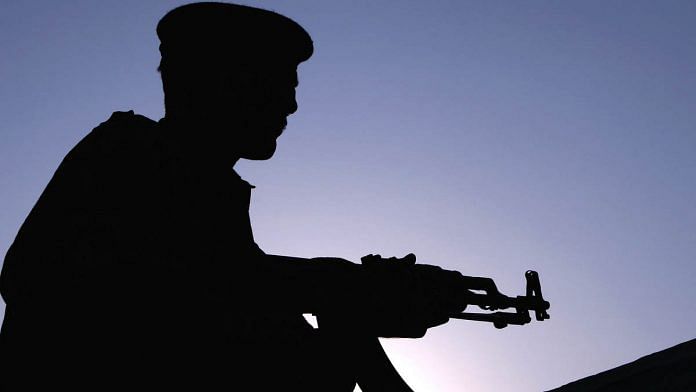A US-based policy platform has analysed Pakistan’s conventional deterrence capability, and said it now has a range of non-nuclear response options.
New Delhi: Pakistan is no slouch when it comes to conventional military deterrence. In fact, it is equipping its military with a dual-track modernisation programme, which can combat India’s denial strategies and limited war aims, according to an article posted by South Asian Voices.
Strengthening its conventional military deterrence will provide the Pakistani military a range of response options and increase the nuclear threshold, “since it will not be forced to retaliate with nuclear weapons as an initial response to a limited conventional incursion”, the article said.
South Asian Voices is an online policy platform for strategic analysis on the region, hosted by the Stimson Center in Washington. The article is part of a series on ‘Post 26/11: Strategic direction or drift?’ which aims to re-evaluate military doctrines, postures and strategies in south Asia.
Also read: When a JNU professor grilled Pakistan Army on why it was not fighting India-centric terror
Details of Pakistan’s strategy
The article said Pakistan has introduced a low-yield, short-range ballistic missile system — HATF-IX/Nasr — which it intends to use as a last resort against Indian forces in case of the failure of conventional defences.
It claimed that Pakistan has adopted a cost-effective solution to India’s proactive war strategies, and was improving its existing platforms to deter them.
The article also pointed out that India is pursuing new conventional weapon technologies to form the basis of its counterforce capabilities, including precision-guided munitions, missile defences, stand-off weapons and cyber operations.
“Pakistan is also updating its conventional strategies, conducting military exercises, improving its weapons systems, and seeking new defence partnerships,” it said.
The article cited the example of Pakistan developing an offensive-defence ‘Riposte’ strategy after 1989, which calls for a Pakistan Army strike corps to launch an offensive in an event of war, aiming to occupy Indian territory near the border while holding back the initial hostile advances.
It said Pakistan had reorganised its strategic reserves, the Army Reserve North and Army Reserve South, and that its six defensive corps are situated in close proximity to Indian territory.
Conventional military exercises such as Azm-e-Nau, New Concept of War Fighting, High Mark, Strike of Thunder and Sea Spark are positioned for better synergy of Pakistan’s three military services and combat readiness along the eastern border. Pakistan is also engaged in negotiations and contracts for upgrades and procurement of conventional armaments from various suppliers, and it’s taking various initiatives in the sphere of additions to or modernisation of its cruise missile programme, air defences, unmanned aerial vehicles, and surface and sub-surface fleet to equip its military.
The article said improvements in air defence would enable Pakistani ground forces to conduct defensive and counter-offensive operations against Indian integrated battle groups (IBGs) or strike corps.
While China had assisted Pakistan in a multi-dimensional strategic partnership comprising civilian nuclear energy, conventional arms sales and military exercises, the country has now included Turkey, Italy and Russia in its list of partners for conventional weapons.
However, in the global firepower ranking list of 2018 released last year, India’s military had retained the fourth position on a global index of 136 countries, while Pakistan military was 17th, down four ranks from the previous year.
Also read: Pakistan Army’s decades-long war on political parties continues







Dear editor or writer
He was never KILLED. He is a martyr.
If you know the difference please correct.
Pakistan’s conventional strength shows that Pakistan is trying to put its all efforts to halt any aggression from Indian side. On the other hand India’s efforts to counter Pakistan’s defense are only for attaining hegemonic status in the region and it will create instability in the region.
Pakistan will maintain deterrence against any Indian threat, whether, conventional or strategic by any means necessary. Indian aggressive military buildup is posing a territorial threat to Pakistan, because more than seventy percent of Indian troops are deploying on Pakistani border, while India is further reducing troops deployment on Chinese border. Pakistan must develop any weapon necessary to defeat the Indian ill designs.
This article has a purpose attached. Pakistan is not conventionally strong when it comes to the comparison with its arch rival. Pakistan spends meager amount on its defense where India spends handsome amount, which allows it to be worlds largest arms importer. Leave alone its nuclear budget for single ISRO. Pakistan has a well professional army that relies on meager defense allocation but its not overwhelming to make its conventional deterrence as effective as India’s
Pakistan has repeatedly proposed the initiation of a strategic restraint regime in the subcontinent but India has dismissed such peace overtures. It is ironical that a State that aspires to revise the global order is not amenable to make peace in its immediate neighbourhood. Charity usually begins at home. Pakistan has no regional or global power ambitions. It has always aspired to live peacefully, if unencumbered with such challenges on its borders.
Pakistan’s defense planners always considered their conventional might as first line of defense against any conventional military attack. In 2001-02 conflict, Pakistan was certain that its military is fully capable of thwarting Indian military advancement. Pakistan strategic deterrence is mostly based on robust conventional military capability and readiness. Any coercive diplomacy by India will always be encountered by deploying Pakistani troops across the international border as exercised in “Azm-e-Nau.”